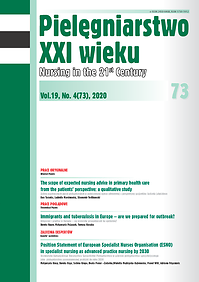Imigranci i gruźlica w Europie – czy jesteśmy przygotowani na epidemię?
DOI:
https://doi.org/10.2478/pielxxiw-2020-0025Słowa kluczowe:
Unia Europejska, imigranci, akty prawne, gruźlica, obywatele UkrainyAbstrakt
IMIGRANCI I GRUŹLICA W EUROPIE – CZY JESTEŚMY PRZYGOTOWANI NA EPIDEMIĘ?
Wstęp. Międzynarodowe podróże i imigracja doprowadziły do wzrostu zachorowań na gruźlicę w krajach europejskich, głównie z powodu migracji z Afryki i Bliskiego Wschodu.
Cel. W tym artykule wskazujemy na dodatkową ścieżkę migracji – z Ukrainy – i zagrożenie gruźlicą związane z tą migracją oraz omawiamy nasze przygotowanie na wzrost zachorowań na tę chorobę.
Dyskusja. Szacuje się, że około 1,5-2,5 mln obywateli Ukrainy pracuje lub mieszka w Polsce lub UE. Wynika to z wdrożenia niektórych dyrektyw UE i przepisów polskiego prawa, które uprościły dostęp obywateli Ukrainy do europejskiego rynku pracy. Co istotne, Ukraina jest jednym z 18 krajów Obszaru Europejskiego WHO, w którym walka z gruźlicą ma najwyższy priorytet i jednym z 20 krajów na świecie o najwyższym wskaźniku występowania lekoopornej postaci gruźlicy. Co więcej, w krajach członkowskich UE nie ma jednolitego programu badań przesiewowych w kierunku gruźlicy u imigrantów. Z tego powodu, nie mamy żadnych wiarygodnych danych co do występowania gruźlicy w żadnej z grup narodowościowych imigrantów w Europie, wliczając obywateli Ukrainy.
Wnioski. Pielęgniarki od zawsze miały do czynienia z chorobami zakaźnymi, zawsze były i będą ostatnią linią obrony przed epidemią. Każdą epidemią, włączając gruźlicę. Być może, wobec braku zintegrowanej polityki przeciwgruźliczej w Europie, naszą jedyną przyszłością są doświadczenie, umiejętności i poświęcenie pielęgniarek.
Bibliografia
1. Rodrigues IL, Motta MC, Ferreira Mde A. Social representations of nurses on tuberculosis. Rev. Bras. Enfermagem. 2016; 69(3): 532-537.
2. World Health Organization, 2018. Tuberculosis. Fact sheets. Retrieved Sept. 29, 2019 from: http://www.who.int/mediacentre/factsheets/fs104/en
3. Aadnanes O, Wallis S, Harstad I. A cross-sectional survey of the knowledge, attitudes and practices regarding tuberculosis among general practitioners working in municipalities with and without asylum centres in eastern Norway. BMC Health Service Res. 2018; 18(1): 987.
4. World Health Organization, 2015. Global tuberculosis report. WHO/HTM/TB/2015. Retrieved Sept. 29, 2019 from http://apps.who.int/iris/bitstream/10665/191102/1/9789241565059eng.pdf
5. Rowinska-Zakrzewska E, Korzeniewska-Kosela M, Augustynowicz-Kopec E, Szturmowicz M. What factors may influence epidemiological situation of tuberculosis in Poland and in the world? Pneumonol. Aler. Pol. 2016; 84(2): 126-133.
6. Guix-Comellas EM, Rozas-Quesada L, Velasco-Arnaiz E, et al. Impact of nursing interventions on adherence to treatment with antituberculosis drugs in children and young people: A nonrandomized controlled trial. J. Adv. Nursing. 2018. doi: 10.1111/jan.13692.
7. Ailinger RL, Black P, Nguyen N, Lasus H. Predictors of adherence to latent tuberculosis infection therapy in Latino immigrants. J. Comm. Health Nurs. 2007; 24(3): 191-198.
8. Lew W, Pai M, Oxlade O, et al. Initial drug resistance and tuberculosis treatment outcomes: systematic review and meta-analysis. Ann. Intern. Med. 2008; 149(2): 123-134.
9. Newton SM, Brent AJ, Anderson S, et al. Paediatric tuberculosis. Lancet Infect. Dis. 2008; 8(8): 498-510.
10. Pang J, Teeter LD, Katz DJ, et al. Epidemiology of tuberculosis in young children in the United States. Pediatrics. 2014; 133(3): e494-504.
11. Rendon A, Centis R, Zellweger JP, et al. Migration, TB control and elimination: Whom to screen and treat. Pulmonology. 2018; 24(2): 99-105.
12. European Centre for Disease Prevention and Control, 2017. Tuberculosis – Annual Epidemiological Report for 2015. Retrieved Sept. 29, 2019 from https://ecdc.europa.eu/en/publications-data/tuberculosis-annual-epidemiological-report-2015.
13. Sane Schepisi M, Navarra A, Altet Gomez MN, et al. Burden and Characteristics of the Comorbidity Tuberculosis-Diabetes in Europe: TBnet Prevalence Survey and Case- Control Study. Open Forum Inf. Dis. 2019; 6(1): ofy337.
14. Robert Koch Institute, 2017. Report on the Epidemiology of Tuberculosis in Germany – 2016. Retrieved Nov. 11, 2019 from http://www.rki.de/EN/Content/infections/epidemiology/inf_dis_Germany/TB/summary_2016.html
15. Boudville DA, Joshi R, Rijkers GT. Migration and tuberculosis in Europe. J. Clin. Tuberc. Other Mycobact. Dis. 2020; 18: 100143.
Pobrania
Opublikowane
Numer
Dział
Licencja
Prawa autorskie (c) 2020 Autorzy

Praca jest udostępniana na licencji Creative Commons Attribution-NonCommercial-NoDerivatives 3.0 Unported License.




